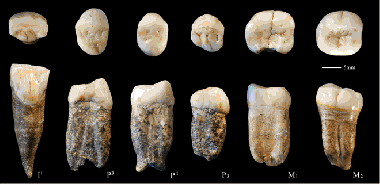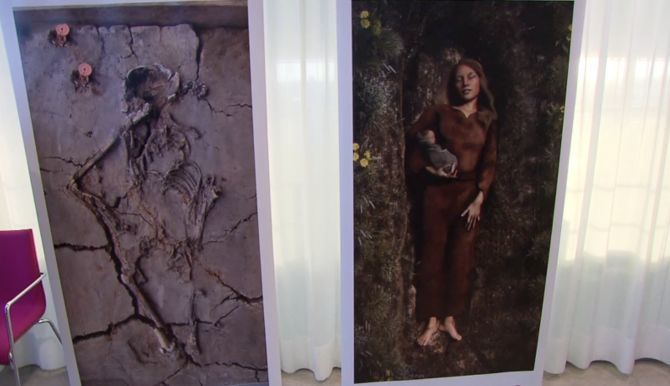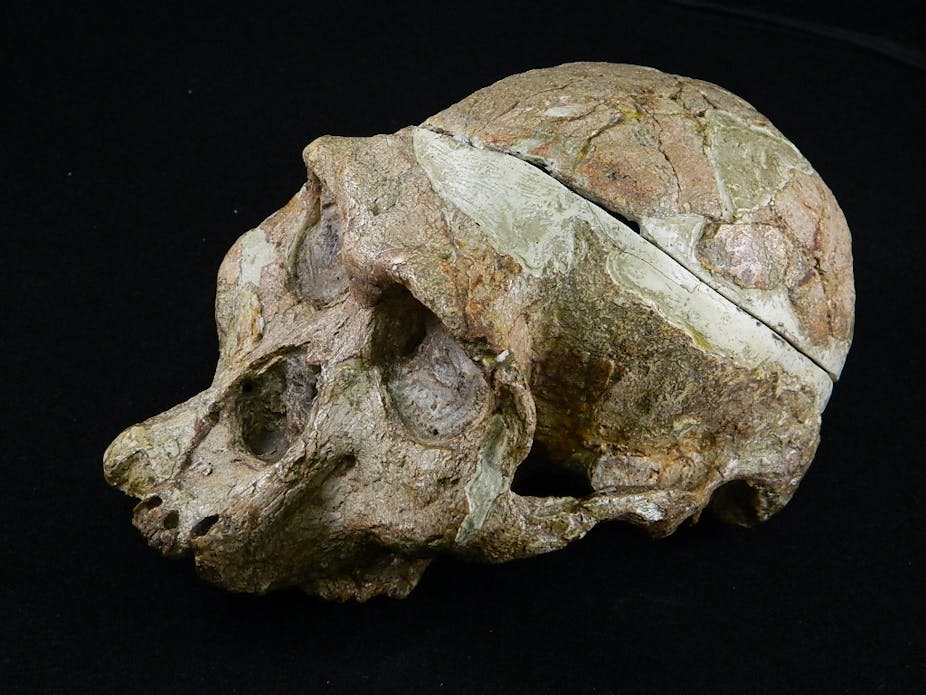 |
| 1/4. Grabado de un zorro del Magdaleniense de Altxerri. http://bertan.gipuzkoakultura.net/img/15/grandes/ZORRO-ALTXERRI) |
Existe una zona en Euskal Herria en la que hay un vacío en el hábitat paleolítico, y esta zona es el valle del Oria.
Las únicas excepciones son el yacimiento de San Adrián, situado en la cabecera de la cuenca, donde recientemente se han identificado ocupaciones del final del Paleolítico Superior (Magdaleniense) (Tapia et al. 2016); Usategi y Pikandita, ambos en Ataun, y ambos dos con evidencias muy escasas, una punta de asta de tipo Isturitz (Rios-Garaizar y Garate, 2014) acompañada de escasas piezas líticas en el primero (Gravetiense), y un arpón aziliense en el segundo (Barandiaran 1977)...
Más sobre Descubren pinturas rupestres prehistóricas en Vilardevós - Faro de Vigo
Fueron halladas por dos expertos en arqueología de la comarca
Recientes estudios confirman la presencia de pintura rupestre prehistórica en el municipio de Vilardevós, descubiertas casualmente en octubre por dos expertos en arqueología de la comarca de Monterrei. Beatriz Comendador, profesora del Área de Prehistoria e investigadora del Grupo de Estudos de Arqueoloxía, Antigüidade e Territorio (Geaat) de la Universidad de Vigo, refiere que son "representaciones en tinta plana de color rojo integrables dentro de la denominada tradición de arte esquemática pintada y que podrían ser obra de las primeras sociedades agro-pastoriles del Neolítico"...
Primer estudio de los únicos fósiles originales conservados del hombre de Pekín | CENIEH / Link 2 / Link 3 / Link 4
 |
| Dientes fósiles originales del Hombre de Pekín/Xing Song et al. CENIEH |
Se trata de seis dientes de Homo erectus hallados en el yacimiento chino de Zhoukoudian, cuya descripción y comparación, en la que han participado investigadores del CENIEH, se acaba de publicar en la revista Scientific Reports
Científicos del Centro Nacional de Investigación sobre la Evolución Humana (CENIEH) forman parte del equipo que acaba de publicar en la revista Scientific Reports un artículo en el que se estudian por primera vez los restos fósiles originales que se conservan del “hombre de Pekín”. Se trata de seis dientes de Homo erectus hallados a mediados del siglo XX en el yacimiento del Pleistoceno Medio de Zhoukoudian (Pekín)...
Las “sofisticadas” armas mortales de hace 14.000 años
Descubren en Holanda restos óseos de 6.000 años de antigüedad de una mujer y un bebé en su brazo derecho / Link 2
 |
| minutenews.fr |
En Nieuwegein (Holanda) se han encontrado restos fósiles de un bebé de hace 6.000 años. Estos son los restos más antiguos y únicos de un infante que los arqueólogos han descubierto en los Países Bajos. El municipio de Nieuwegein ha anunciado el descubrimiento un año después de que fueran sacados de la tierra. Los arqueólogos han estado excavado y sacando a la luz restos humanos en el parque empresarial de Het Klooster, en Nieuwegein (Holanda), durante los últimos dos años. Son individuos pertenecientes a la cultura llamada Swifterbant, un pueblo que vivió en los Países Bajos entre 5.300 y 3.400 a.C., los cuales cazaban animales a lo largo de los ríos.
La excavación arqueológica halló que el esqueleto intacto de una mujer tenía el brazo derecho doblado (no recto). Con base a esta posición inusual en la cultura Swifterbant tuvieron la primera sospecha de la posible existencia de un bebé en dicho brazo, lo cual fue confirmado al encontrarse restos del cráneo, de una clavícula, un hueso de la pierna y dientes de leche, pertenecientes a un bebé que probablemente tenía entre 0 y 6 meses de edad. La edad de la mujer se estima que tendría unos 20 o 30 años...
¿Las primeras poblaciones agrícolas y ganaderas vivían en idílica armonía con el entorno como se supone a menudo? - Fundación Palarq
... Un equipo de arqueólogos coordinados desde el Consejo Superior de Investigaciones Científicas (CSIC) y dirigido por el Prof. Juan José Ibáñez lleva más de diez años trabajando en Próximo Oriente (Siria, Líbano y Jordania) para conocer cómo y por qué las poblaciones humanas se sedentizaron y comenzaron a vivir de la agricultura y de la ganadería. Entre los yacimientos excavados en Siria con anterioridad al inicio del conflicto civil se encuentra Tell Qarassa, poblado neolítico con una cronología que abarcaría desde mediados y hasta finales del 9º milenio antes de Cristo. En un estudio liderado por Amaia Arranz, de la Universidad de Copenhague, recientemente publicado en la revista Quaternary Science Reviews, este equipo ha estudiado cómo cambió el entorno natural del asentamiento durante los 400 años aproximadamente que duró la ocupación...
El origen del hombre no era como pensábamos | XLSemanal
¿Quiénes fueron los primeros humanos sobre la Tierra? Hasta hoy se creía que África fue la cuna del ‘Homo sapiens’, pero… restos de ADN, investigaciones genéticas y revolucionarios hallazgos paleontológicos están dándole la vuelta a la imagen que teníamos sobre el origen de nuestra especie...
Menos trabajo y más cooperación: la Prehistoria no fue tan miserable como nos la contaron
Existen muchos mitos en la cultura popular sobre la Prehistoria, en su mayor parte cuestiones inocuas y de sencilla refutación. Por ejemplo, debe decirse que, pese a lo que aparezca en series infantiles de ficción como Los Picapiedras o películas como la protagonizada por Ringo Starr, El cavernícola, los dinosaurios y los seres humanos no convivieron: los primeros se extinguieron hace 65 millones de años y los segundos aparecieron hace tan solo 2 millones de años...
---
Universidade de Coimbra ajuda a valorizar arte rupestre do Vale do Côa - Notícias de Coimbra / Link 2
A secretária de Estado da Ciência, Tecnologia e Ensino Superior, Maria Fernanda Rollo, disse hoje que será criado um grupo de trabalho que perspetive e identifique as áreas de investigação científica relevantes da arqueologia da Arte do Côa...
Vídeo. Ce que nous disent les tablettes de Plougastel | CNRS Le journal
Sous le Rocher de l’impératrice, à la pointe du Finistère, ont été déterrées des plaquettes de schiste ornées de gravures d’un style graphique inédit. Vieilles de 14 000 ans, elles témoignent d’un moment charnière, lié à des progrès techniques, dans l’évolution de notre histoire. Leur analyse permet d’éclairer davantage le mode de vie de ces sociétés paléolithiques...
First study of the only original fossils conserved of Peking Man | CENIEH
 |
| Dientes fósiles originales del Hombre de Pekín/Xing Song et al. CENIEH |
This is a study on six teeth of Homo erectus found at the Chinese archaeological site of Zhoukoudian, whose description and comparison, in which researchers from the CENIEH have participated, has just been published in the journal Scientific Reports...
6,000-year-old baby with teeth found cradled in mother's arm in Netherlands grave
 |
| speld.nl |
A 6,000-year-old baby with its teeth still intact and resting in the arms of a woman, believed to be its mother, has been found in a grave in the Netherlands.
Archaeologists said it was the oldest baby grave ever found in the Netherlands. The grave, uncovered at a site in Nieuwegein in the province of Utrecht, dates back to the Stone Age.
The discovery only came to light after four exhumed skeletons were examined by archaeological consultancy RAAP in Leiden.
Scientists noticed that the right arm of the 30-year-old woman's skeleton was bent at a strange angle. It was crooked instead of straight - the usual posture of other skeletons at the site.
Closer inspection showed bone fragments of an infant by her arm and revealed that the woman was buried cradling a baby...
6000 jaar oud babyskelet in arm vrouw gevonden in Nieuwegein | NOS / Link 2 (Vídeo*) / Link 3 (Vídeo 2017)
In Nieuwegein is een bijzondere archeologische vondst gedaan: een babyskelet van 6000 jaar oud. Het kindje zou hebben behoord tot de Swifterbantcultuur, de eerste landbouwende cultuur in Nederland. Het is het eerste babyskelet dat is gevonden uit die periode. Archeologen komen baby's niet vaak tegen, omdat het kraakbeen meestal vergaat... (Vídeo)
*. Vídeo. Oudste babygraf van Nederland ontdekt in Nieuwegein | NieuwegeinTV.
Ver en PaleoVídeos > L.R.2.15 nº 18.
One of the world's most famous fossil skulls, "Mrs Ples", is actually a "Mr"
 |
| A study of “Mrs” Ples’ tooth sockets has made scientists think differently about “her” sex. Ditsong National Museum of Natural History |
More than 70 years ago two palaeontologists named Robert Broom and John Robinson discovered a skull at the Sterkfontein Caves near Johannesburg. They nicknamed the skull, which is believed to be about 2.5 million years old, “Mrs Ples”.
Its scientific name is Australopithecus africanus, and it’s extremely significant because scientists believe it to be a distant relative of all humankind. The fossil represents part of the evidence demonstrating that Africa is the continent from which all humanity originated.
In the decades since then the skull’s sex has become the subject of some debate. Not everyone has been convinced by Broom’s insistence that “Mrs Ples” was a female of her species.
Our new research, just published in the South African Journal of Science, offers compelling proof that the naysayers were right. “Mrs” Ples was actually a “Mr”...
Reconstructing an ancient lethal weapon
Language is Learned in Brain Circuits that Predate Humans | Georgetown University / Link 2
It has often been claimed that humans learn language using brain components that are specifically dedicated to this purpose. Now, new evidence strongly suggests that language is in fact learned in brain systems that are also used for many other purposes and even pre-existed humans, say researchers in PNAS (Early Edition online Jan. 29).
The research combines results from multiple studies involving a total of 665 participants. It shows that children learn their native language and adults learn foreign languages in evolutionarily ancient brain circuits that also are used for tasks as diverse as remembering a shopping list and learning to drive...
DNA From Lost Ice Age Peoples Sheds Light On Our Neanderthal Heritage | IFLScience
Studies of DNA from peoples who lived during the last Ice Age, or shortly after, are helping us understand the origins of modern population groupings, and how we relate to archaic humans.
A review of these finds, published in Trends in Genetics, reveals that around 40,000 years ago Europe and Siberia were populated by at least two peoples who have left no genetic trace among modern populations. They can, however, help us understand our connection to the Neanderthals. The period 45-35,000 years ago is known in anthropology, somewhat contradictorily, as “Ancient Modern A” (AMA). Fossils from this period, particularly those from which we can extract DNA, are rare...
Ancient Ale: Oldest Beer in Greece Dates to Bronze Age
The ancient Greeks may have liberally indulged in wine, but that's not the only alcoholic beverage they imbibed, according to a new study that describes the discovery of two potential Bronze Age breweries.
The "stout" discoveries mark what may be the oldest beer-making facilities in Greece and upend the notion that the region's ancient go-to drink was only wine, the researchers said...
Modern Man vs. Giant Animals - Mega-herbivores were displaced by humans who partly took their place
Senckenberg scientist Hervé Bocherens has studied the extinction of mega-herbivores – plant-eating animals that weighed more than one ton – that occurred approx. 12,000 years ago. The scientist from Tübingen reached the conclusion that, on the one hand, modern man was the cause of these giant terrestrial animals’ extinction, and on the other hand, humans took over part of the animals’ ecosystem functions. In his study, recently published in the scientific journal “Frontiers in Ecology and Evolution,” he concludes that the reintroduction of large animals in certain parts of the world could have a positive effect in regard to species diversity...
Más sobre Northumberland Bronze Age skeleton: Whose bones are these? - BBC News
Forensic scientists have been analysing Bronze Age bones found in a field - but how do they work out who the person was?
In September 2017, a farmer near Rock, Northumberland, preparing his field for drainage discovered a burial cist - or stone coffin - containing a skeleton and a jug... (Vídeo)
Journalist Paul Salopek explores ancient path of human migration | Asia| An in-depth look at news from across the continent | DW
American journalist Paul Salopek is in the middle of his 21,000-mile odyssey on foot that retraces the path of human migration. DW spoke to him about his journey and how it changed his outlook on mankind...
Más noticias / More news









No hay comentarios:
Publicar un comentario